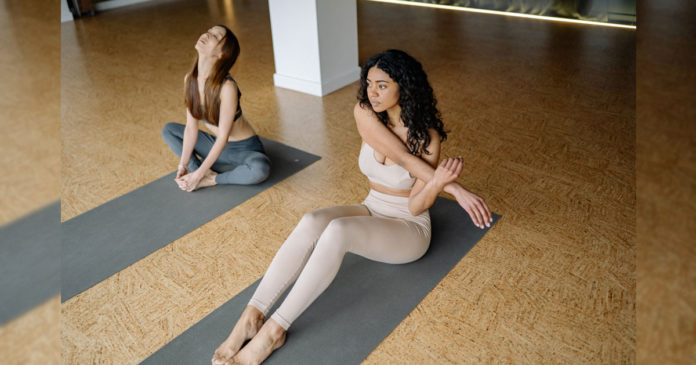Meditation and yoga have been connected for millennia, both of which originated in ancient India. While they are separate disciplines, they have a strong connection and compliment each other in unique ways. In this part, we will look at the link between yoga and meditation, such as whether it is preferable to practice meditation before or after yoga, the advantages of doing both, and how they might improve our general well-being.
Better to do meditation before or after yoga ?
One often asked issue is whether it is better to do meditation before or after yoga. The answer is primarily determined by personal preferences and ambitions. Some people like to begin the process with meditation to clear their minds and establish objectives before progressing into physical postures. Others find that including meditation at the conclusion of their yoga practice aids in the integration of the physical advantages of yoga to a state of profound relaxation.
Whatever decision you make when you include meditation before or after yoga, both offer several overlapping advantages. Both yoga and meditation encourage mindfulness, which is defined as paying complete attention to the moment at hand without judgment. This increased awareness may help decrease stress and anxiety while also improving mental clarity.
Aside from awareness, integrating meditation and yoga may improve physical well-being. Asanas (postures) in yoga assist to strengthen the body, enhance flexibility, and regulate energy levels while also boosting general physical fitness. Meditation supplements these physical advantages by helping practitioners to grow self-awareness and connect on a deeper level with their inner selves.
Furthermore, for those wanting a more comprehensive approach to their practice, practicing meditation before or after yoga may build a deeper feeling of spiritual connection. Individuals who consistently incorporate these activities may enjoy an elevated sense of inner serenity, self-discovery, and spiritual progress.
Finally, knowing the link between yoga and meditation is critical for reaping the most advantages from both practices. Whether you meditate prior to or following your yoga workout, or include meditation into your daily practice of yoga, combining both of these disciplines may have a significant influence on your general well-being. You may build a healthy balance that encourages physical health, mental focus, and spiritual progress by nourishing both the body and the mind.
The Benefits of Practicing Meditation Before Yoga
Meditation practice before a yoga lesson may provide several advantages that improve the whole experience. Individuals may prepare their thoughts for yoga by adopting mindfulness practices before the practice, resulting in a more intense and concentrated session.
The ability to quiet the mind and create relaxation is one of the key benefits of meditating before yoga. Meditation before or after yoga enables people to release themselves of any tension or distraction they may be bringing around, resulting in a more calm state of mind. This mental clarity lays the groundwork for a fruitful and satisfying yoga practice.
Meditation before or after yoga also improves self-awareness and draws attention to the current moment. Individuals get more in sync with their body and emotions by concentrating on their breath or a particular mantra during meditation. This increased awareness pervades the next yoga practice, enabling practitioners to completely participate with every motion and position.
Furthermore, meditating before yoga improves attention and concentration. Meditation helps to remove thoughts and external distractions by quieting the mind. As a consequence, throughout their yoga practice, people are better able to focus on their breathing, body sensations, and alignment. This heightened attention allows for greater connection with each position and enhances the physical advantages of yoga.
In conclusion, embracing meditation before commencing a yoga practice has several benefits. It prepares the mind and body for the best possible experience by encouraging relaxation, increasing self-awareness, and boosting focus and concentration. Individuals may unleash more potential in their entire well-being journey by committing time to mindfulness exercises prior to participating in yoga.
The Benefits of Practicing Meditation After Yoga
Following yoga with meditation has several advantages that might improve your general well-being. Taking a moment to meditate after a physical activity, such as yoga, allows for deeper calm as well as integration of both the mind and the body.
The cultivation of a feeling of calm and inner peace is one of the key advantages of using meditation after yoga. Yoga helps to alleviate stress in the human body, while meditating quiets the mind even more, allowing for a deeper level of relaxation. This combination may help relieve tension and anxiety, resulting in a greater feeling of calm in everyday life.
You may build attention and awareness by introducing meditation into the practice of yoga. During meditation, you create a heightened sensation of presence and attention by focusing on your breath or a single topic of concentration. This attention may then be used outside of the mat, improving your capacity to be present and involved in each moment.
Additionally, meditating after yoga helps strengthen the link between your both mental and physical moods. Yoga poses prepare the body for meditation by releasing stress and improving flexibility, allowing you to sit calmly for extended periods of time. By combining these two techniques, you may achieve a harmonic balance of body and mind.
Overall, including meditation after yoga has several advantages that go beyond the physical components of both disciplines. It encourages deeper relaxation while also building awareness and inner calm. You may enjoy higher overall health in both body and mind by devoting time to this combination practice on a regular basis.
Considering Your Personal Preferences and Goals
Personal tastes and individual objectives play a vital part in establishing the perfect balance for your requirements when it comes to yoga and meditation practice. Everyone has varied preferences for meditation methods, yoga methods, and the entire environment in which they practice.
Some people enjoy an aggressive and dynamic yoga practice, which includes Vinyasa or Power Yoga, whereas others prefer a slower-paced and soothing approach, such as Yin or Restorative Yoga. Similarly, some individuals may choose mindfulness meditation for alleviating stress and clarity of thought, while others may prefer compassion or transcendental meditation for these reasons.
It is essential to experiment with meditation before or after yoga and solutions in order to determine what works best for you. Take note of how each method or style affects you physically, psychologically, and emotionally. Consider your objectives, whether they be to improve flexibility, reduce anxiety, improve attention, or cultivate inner peace, and choose activities that support those aims.
Finding the proper balance for your demands also requires taking into account issues like availability of time and physical limits. Shorter sessions of meditation or yoga classes that may be included into your everyday routine may be more acceptable if you’re dealing with a hectic schedule. Furthermore, if you have any special health problems or injuries, you should talk with a trained teacher who can assist you toward adaptations that assure safety while still accomplishing your objectives.
When it pertains to meditation before or after yoga, keep in mind that there is not a universal technique. It’s about respecting your own tastes and ambitions while becoming open to new opportunities along the route. You may establish a practice that gives satisfaction and improves your general well-being by paying attention to yourself and keeping alert to what feels appropriate for you individually.
Tips for Incorporating Meditation
Maintaining a steady yoga practice schedule may be difficult, but including mindfulness into your routine can improve your whole experience significantly. Meditation before or after yoga not only serves to relax the mind and relieve tension, but it also aids in the deepening of your relationship with your physical being and breathing during yoga.
To begin, finding guided meditation programs made exclusively for yogis may be really beneficial. These publications often provide advice on how to effortlessly incorporate meditation into the practice of yoga. They may incorporate particular meditations that correspond to certain asanas or an emphasis on breathwork in addition to physical postures.
Exploring several kinds of meditation before or after yoga methods in addition to your asana practice may provide diversity and depth to your daily routine. You may try several types of meditation, such as mindfulness, compassion, mantra-based, or imagery meditations. Each strategy provides distinct advantages and insights, enabling you to discover what works best for you.
When introducing mindfulness into your daily yoga regimen, keep in mind that consistency is essential. Make time every day or week to engage in both practices, and devise a meditation before or after yoga routine which works for you. You’ll eventually feel the transformational impacts of integrating these two strong activities in harmony if you make it a habit.
Exploring the Synergy Between Meditation and Yoga is Key to Finding Inner Balance
Finding inner balance via the combination of meditation and yoga, in conclusion, is a journey that involves experience and research. Individuals may get the mental, physical, and spiritual advantages of these two techniques by meditation before or after yoga.
When it involves establishing inner balance, it is important to remember there is no universal solution. The requirements and tastes of each individual may differ. As a result, it is critical to experiment with various tactics and strategies to determine which one works best for you.
Meditation before or after yoga may help each other in a variety of ways. While meditation promotes concentration and awareness, yoga offers a physical expression for movement and mobility. They work together to generate a synergy that improves general well-being.
By adding these disciplines into your routine, you may enhance your attention, decrease stress, raise self-awareness, and develop a stronger connection with yourself. Keep in mind that developing inner equilibrium is a lifelong path of self-discovery.
Finally, investigating the connection in meditation before or after yoga is critical to achieving inner equilibrium. Accept the chance to try out various ways until you discover the mix that works best for you. With commitment and a willingness to learn, you may begin on a revolutionary journey toward inner peace.









